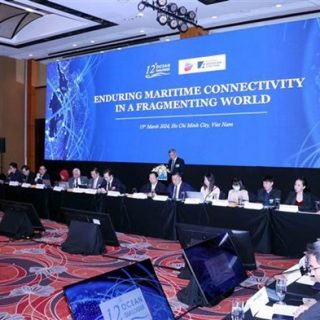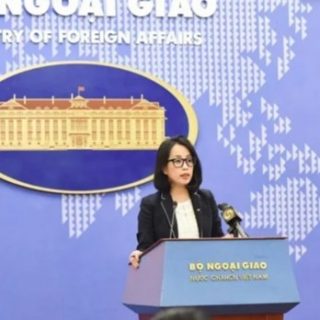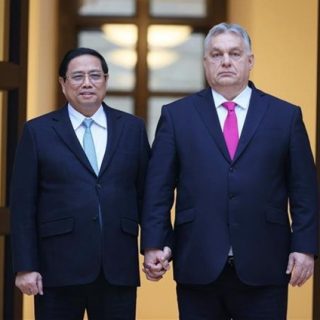China’s ambition to “monopolize control” of the South China Sea is not only having command over the waters adjacent to Vietnam, the Philippines, Malaysia… in the South China Sea but also controlling waters thousands of kilometers away from China such as those close to Indonesia’s Natuna Islands. Although Indonesia has been vigilant, reacting fiercely and striving to protect its territorial sovereignty, it seems that their measures are not strong enough to stop China’s ambition.

(Location of Natuna islands)
The Natuna Islands, which belongs to Riau Province of Indonesia, consists of 272 large and small islands, located in the South China Sea, between the Malay Peninsula and the Borneo Peninsula and surrounded by a vast sea area with the population of more than 100,000. The archipelago has a wide range of resources such as marine produces, seafood, oil and gas reserves, and diverse ecosystems. The Natuna Islands stand in an important maritime route through the South China Sea, which connects the Strait of Malacca with the Java Sea. This is a lifeline route connecting the Pacific Ocean with the Indian Ocean; Europe, the Middle East and Africa with Asia, South Asia and Southeast Asia. Over a quarter of the world’s goods are shipped via this route. It is also a critically strategic trade route of Northeast Asian economies such as China, Taiwan, Japan and South Korea. Besides, the Natuna Islands are considered a special strategic location in monitoring activities in the South China Sea, including military and maritime security activities
In theory, the waters around the Natuna Islands in the southern part of the Malacca Strait have nothing to do with the territorial waters that China claims sovereignty over, because it is too far away from Chinese territory, over a thousand kilometers. According to the United Nations Convention on the Law of the Sea, it is three times further than the distance that China can claim. But the problem here is that China issued the statement on a “9-dash line”, the tip of which overlaps with Indonesia’s exclusive economic zone (EEZ) in the waters of the Natuna Islands. Beijing did not clarify its position on Indonesia’s exclusive economic zone in that area. Therefore, the exclusive economic zone that Indonesia claims currently has a no-small area overlapping with the waters within the “9-dash line” that China deliberately draws to claim its sovereignty in the South China Sea. According to China’s explanation, this sea area is both a historic area with the “Maritime Silk Road” established by Chinese many centuries ago, and a long-standing “traditional fishing grounds” of this country’s fishermen. On that basis, China began to eye and encroach this sea of Indonesia.
It must be said that, from a strategic angle, generations of the Chinese leadership have targeted Southeast Asia and its surrounding waters, and planned to gain control over this area for a long time. Mao Zedong’s statement that “I will lead 500 million Chinese farmers to march south” after the establishment of the People’s Republic of China was very typical of the Chinese leaders’ intention to control Southeast Asia. Accordingly, the Islands of Natuna and its surrounding waters in the South of the South China Sea are also located in the South China Sea. Having control over the entire South China Sea could help China quickly increase the number of commercial goods shipped, reducing the costs and ensuring more safety than using other routes. On the way for China to become a world power, the South China Sea maritime route from the Natuna Islands to the Malacca Strait will be vital to the Chinese economy, and therefore, it needs to manage this route itself to strengthen national security and expand its existence space.
Therefore, on the one hand, China insists on its long-time stance on the irrational “9-dash line” and throws allegations and fabricated documents on historical “evidence” for the so-called “traditional fishing grounds”. On the other hand, it has promoted field activities at sea, such as sending fishing vessels into the Natuna waters to exploit seafood, forcing Indonesia to react, turning “non-disputed waters into disputed waters” to gain public support. However, China’s desire has not been supported by countries in the region. In November 2015, after Indonesia announced that it could sue China to the International Criminal Court if the dispute in the Natuna Islands could not be solved by dialogue, China stated that it has no objection to Indonesia’s sovereignty over the Natuna Islands. But in return, Indonesia must reaffirm that it has no territorial claim to the Spratly Islands in the South China Sea, which is called Nansha Islands by China. They hoped this way would help put Indonesia out of the sovereignty disputes in the Spratly Islands, leaving the strongest claimant Vietnam alone, allowing China to break the bundle of sticks one by one.
Although China publicly acknowledged Indonesia’s sovereignty over the Natuna Islands in the South China Sea and that “it had no problem to be solved with Jakarta”, it also said that this was not applied to Natuna’s exclusive economic zone. One of China’s major strategies is to gain control over the arteries of global trade, especially the maritime routes in the South China Sea, in order to increase its power. Therefore, along with the continuation of the declaration of the “9-dash line” and the disputes over the seas and islands with Vietnam and the Philippines, etc., China keeps on using the concept of “historical sovereignty” and “traditional fishing grounds” to justify the violations by its fishing boats, maritime surveillance and coast guard vessels in the Natuna waters. Since early 2016, China has made a series of violations into the exclusive economic zone of the Natuna Islands, i.e. collisions between Chinese and Indonesian vessels, diplomatic and legal disputes and statements relating to Indonesia’s maritime sovereignty. Typically, on June 17, 2016, the Indonesian Navy was forced to fire a warning against 12 Chinese fishing vessels operating in the waters off the Natuna Islands, arrested the fishing boat Yu 19038 and 7 crew members. Immediately, the Chinese Ministry of Foreign Affairs vehemently protested, arguing that Indonesia’s maritime forces used force to injure Chinese crew members, and asserting that Chinese fishing vessels have the right of free fishing in “Chinese traditional fishing grounds”. Chinese Foreign Ministry spokesperson Hua Chunying said: “China and Indonesia have overlapping claims on maritime rights and interests.” To protect this position, on June 24, 2016, Chinese Navy sent the No. 409 Fleet (including attack submarines, guided-missile destroyers and rescue ships) to the Banda Aceh Sea, in the North of the Natuna Islands, to observe and protect its fishing vessels. Public opinion in Indonesia and other countries in the region had to consider this as a new Chinese move to increase pressure on Indonesia while the two countries often had “collisions” around the Natuna Islands.
It could be said that China’ continuous ambiguous messages on the limits of sovereignty over the Natuna Islands as well as its ‘salami slicing’ tactic by actively creating small collisions and slowly intervening to avoid strong reactions from the opponents, thus leading to a strategic change on the field, have made Indonesia somehow confused. So far, the Indonesian Government has always been lack of initiative in dealing with and proposing appropriate solutions to maritime sovereignty issues, including the control of the exclusive economic zone of the Natuna Islands. There are also different views within the Indonesian government itself on choosing between economic and political interests in its relations with China. Beijing clearly understands this and is taking active advantage of Jakarta’s weakness to gradually take the upper hand in turning Indonesia’s legitimate EEZ and continental shelf from a non-dispute area into a disputed zone with China.
On this, experts from the Indonesia’s Centre for Strategic and International Studies noted: “As the right time arrives, the notion of historical sovereignty plus a prepared reservation of some provisions of the 1982 UNCLOS will help China make new statements to legitimize the so-called 9-dash line and as such, a no-small portion of the Natuna Islands falls into Chinese territory as a matter of fact.” The commander of the Western Fleet of the Indonesian Navy, Rear Admiral A. Taufiq, pointed out: “When a country claims sovereignty over a territory, it must be present there. The Chinese way is to deploy fishing boats to the Natuna Islands in the form of illegal fishing, creating real-scene evidences to claim sovereignty in the South China Sea”.
Thus, by its ambiguous attitude in the recognition of Indonesian sovereignty over the Natuna Sea, combined with the regular penetration of fishing boats, maritime surveillance and coast guard vessels in the territorial waters of Indonesia, turning a non-disputed sea into a disputed one, progressively claiming sovereignty over the Natuna Islands, China has been taking steps to realize “total sovereignty” over the South China Sea, notwithstanding the waters belongs any Southeast Asia countries. In this situation should Southeast Asian countries ride a lone horse in the fight with China for sovereignty over islands and waters?

Aufrufe: 418

 Deutsch
Deutsch Tiếng Việt
Tiếng Việt





